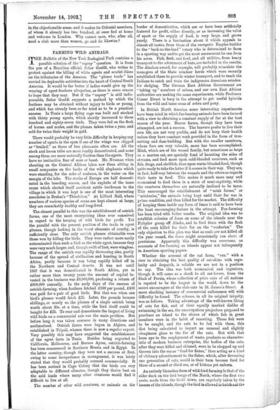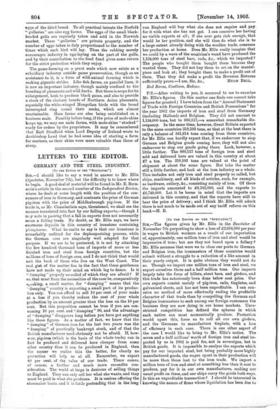FARMING WILD ANIMALS.
MHE Bulletin of the New York Zoological Park contains a -I- possible solution of the " osprey " question. It is from the pen of a Brazilian official, Seiler Goeldi, who writes to protest against the killing of white egrets and scarlet ibises on the tributaries of the Amazon. The "plume trade" has carried its deplorable activities into the heart of Central South America. It would be far better if ladies would give up the wearing of egret feathers altogether, as there is some reason to hope that they may. But if the " osprey " is still indis- pensable, Seiler Goeldi suggests a method by which the feathers may be obtained without injury to birds or young, and which has already been so far tried as to be a practical success. In Tunis a large flying cage was built and stocked with thirty young egrets, which shortly increased to three hundred and eighty-seven birds. They were fed on the flesh of horses and mules, and the plumes taken twice a year, and sold for twice their weight in gold.
There would probably be very little difficulty in keeping any number of egrets in the open if one of the wings was clipped or " brailed," as those of hen pheasants often are. All the stork and heron tribe are most readily domesticated, and none among them are more naturally fearless than the egrets. They have no instinctive fear of man or beast. Mr. Neuman when shooting on the Central African lakes saw them sitting in small companies on the backs of the wild elephants which were standing, for the sake of coolness, in the water on the margin of the lake. The storks of Europe are half domesti- cated in the breeding season, and the exploits of the tame crane which elected itself assistant cattle herdsman to the village in which it was kept is one of the most interesting anecdotes in Brehm's " Thierleben." At Lilford Hall, where numbers of various species of crane are kept almost at large, they are remarkably healthy and long-lived.
The closest parallel to this was the establishment of ostrich farms, one of the most enterprising ideas ever conceived in regard to the keeping of wild birds for profit. Yet the parallel with the present position of the trade in egret .plumes, though lacking in the worst elements of cruelty, is sufficiently close. The only ostrich plumes obtainable were those won by killing the birds. They were rather more easily exterminated than such a bird as the white egret, because they were very much larger, and, though swift of foot, were wingless. The range of the ostrich was rapidly decreasing also, partly because of the spread of civilisation and hunting in South Africa, partly because it- was being rapidly killed off in the Northern and Central deserts. It was not until 1867 that it was domesticated in South Africa, yet in rather more than twenty years the amount of capital in- vested in the business was £8,000,000, producing a return of £800,000 annually. In the early days of the success of ostrich-farming, when feathers fetched £100 per pound, £400 was paid for a pair of good birds. But that was when one bird's plumes would fetch £25. Later, the pounds became shillings, or nearly so, the plumes of a single ostrich being worth about 30s. at a time, while the bird itself could be bought for £25. To rear and domesticate the largest of living wild birds on a commercial sale was the main problem. But before long it was taken overseas in many directions and acclimatised. Ostrich farms were begun in Algiers, and established in Tripoli, whence there is now a regular export. Very possibly this may have suggested the establishment of the egret farm in Tunis. Besides being exported to California, Melbourne, and Buenos Ayres, ostrich-farming has been commenced in Southern Russia and in Egypt. In the latter country, though they were not a success at first, owing to some inexperience in management, it was lately stated that they would probably succeed commercially. It has been noticed in Cape Colony that the birds are very adaptable to different climates, though they thrive best on the arid lands where many other creatures would find it difficult to live at all.
The number of other wild creatures, or animals on the border of domestication, which are or have been artificially fostered for profit, either directly, or as increasing the value of sport or the supply of food, is very large, and grows yearly. There is a fascination about it which appeals to almost all tastes, from those of the energetic Empire-builder to the " back-to-the-land " votary who is determined to farm in a sporting way and to get the most amusement he can from his acres. Fish, flesh, and fowl, and all utilities, from heavy transport to the adornment of hats, are included in the results. The Alaskan award, for example, will probably stimulate the managers of the State reindeer herds which were recently established there to provide winter transport, and to teach the Indians to catch and train the indigenous American reindeer, for sledging. The German East African Government are "taking up" numbers of zebras, and our own East African authorities are making the same experiments, while Professor Cosser Ewart is busy in the attempt to get useful hybrids from the wild and tame cross of zebra and pony.
In British North America some interesting experiments have been tried in which fur-bearing animals have been farmed with a view to obtaining a constant supply of fur at the best season of the year. Beaver farms, though they have been attempted, are not a success. The beavers prefer to live their own life, are not very prolific, and do not keep their health unless they have constant work provided in the form of tree- cutting and dam-building. But with the smaller carnivora, whose furs are very valuable, more has been accomplished. Mink, which are of the weasel family, but sometimes as large as a marten eat, are specially fond of haunting the sides of streams, and feed more upon cold-blooded creatures, such as fish, frogs, and shellfish, than upon warm-blooded food, though quite ready to take the latter if it comes in their way. They are, in fact, half-way between the weasels and the otters as regards their taste in food. This makes it much more easy and economical to feed them in a state of semi-captivity, while the creatures themselves are naturally inclined to be tame. This encouraged the establishment of " mink farms," or " minkeries," the animals being kept until their fur was in prime condition, and then killed for the market. The difficulty of keeping them inside any form of fence is said to have been the least encouraging feature in the attempt. Fox-farming has been tried with better results. The original idea was to establish colonies of foxes on some of the islands near the Pribylov group off Alaska, and to feed them with the flesh of the seals killed for their fur on the " rookeries." The only objection to this plan was that as seals are not killed all the year round, the foxes might occasionally run short of provisions. Apparently this difficulty was overcome, as accounts of fox-farming on islands appear not infrequently in American sporting papers.
Whether the account of the cat farm, " run " with a view to obtaining the best quality of cat-skins with regu- larity and despatch, is reliable we are not in a position to say. The idea was both economical and ingenious, though it will come as a shock to all cat-lovers, from the Shah of Persia, whose collection of prize cats of all nations is reputed to be the largest in the world, down to the secret encouragers of the club cats in St. James's Street. A more shocking instance of commercial callousness will with difficulty be found. The scheme, in all its original iniquity, was as follows. Taking advantage of the well-known liking of cats for fish, and of their equally marked dislike of swimming in the sea, the unscrupulous projectors proposed to purchase an island to the shores of which fish in great numbers were in the habit of resorting. These fish were to be caught, and the cats to be fed with them, this diet being calculated to impart an unusual and slightly oleaginous gloss to the fur of the cats. But with that keen eye to the employment of waste products so character- istic of modern business enterprise, the bodies of the cats, after they were killed and skinned, were to be chopped up and thrown into the sea as "food for fishes," thus acting as a kind of obituary advertisement to the fishes, which, after devouring one generation of cats, would in their turn become food for those of a second or third era, or of kittens yet unborn.
An entirely blameless form of wild-bird farming is that of the eider duck on the bird bergs of the North, where the first two nests, made from the birds' down, are regularly taken by the lessees of the islands, though the bird is allowed to hatch out the
eggs of the third brood. To all practical intents the Norfolk " galleries" are also egg farms. The eggs of the small black- headed gulls are regularly taken and sold in the Norwich market. These " galleries " are private property, and the number of eggs taken is duly proportioned to the number of times which each bird will lay. Thus the robbing merely encourages industry in egg-laying on the part of the gulls, and by their contribution to the food fund gives some return for the strict protection which they enjoy.
The game-farming on a great scale which now exists as a subsidiary industry outside game preservation, though as an assistance to it, is a form of wild-animal farming which is making gigantic strides. Like fish farms, on parallel lines, it is now an important industry, though mainly confined to the breeding of pheasants and wild ducks. But there is scope for its enlargement, both to produce black game, and also to provide a stock of the choicest breeds of Northern Asian pheasants, especially the white-winged Mongolian birds with the broad interrupted ring round their necks, which are almost unattainable. Hare farms are also being established on a business scale. Possibly before long, if the price of mole-skins keeps up, we may see mole farms, with mole-skins " stocked " ready for orders by the proprietors. It may be remembered that Earl Strafford when Lord Deputy of Ireland wrote to Archbishop Laud that he had some idea of starting a farm for martens, as their skins were more valuable than those of sheep.















































 Previous page
Previous page